Skip to content

 5 things to know about lessons learned reports
5 things to know about lessons learned reports
Document the lessons learned throughout a project’s life cycle with this template designed for project management.
A lessons learned report is a project document that contains all the experiences and knowledge gained throughout a project’s lifecycle. Unless you document the lessons learned, it can be difficult for your project team to know what they did right or the areas where they need to improve.
Here are the 5 most important things to know about lessons learned––and how to write a lessons learned report using this free template.
1. What are lessons learned in project management?
In this case, lessons learned are the knowledge gained, both positive and negative, through project experiences.
Lessons learned can be documented at different time frames, including during and after project completion. Therefore, this report should be set up at the start of a project to include the project goals and success metrics.
A lessons learned report helps project managers and their teams identify the root causes of problems or wins of their past projects. This report serves as a historical document to learn how to avoid these problems or set themselves up for success again on future projects.
For example, suppose you’re working on a project titled “Launch Alpha version of product”. With a lessons learned report, you would record both positives and negatives of that project and in a shared doc.
Lessons learned report template example
This template was built in Coda, the all-in-one-doc that brings words, data, and teams together.
Play with this template below. And then to save your edits.
Learn more about how to use this template to document a lessons learned report below.
Make a copy
Using the previous example, “Launch Alpha version of product,” the team should highlight what went well, what didn’t go well, and who was involved in this project.
Lessons example
Search
Alpha Launch
We did not have the best Road Map for launch and many tasks were rushed in the final sprint of the project
Alpha Launch
Project
Release alpha version of product
What went well?
Successful launch with user feedback and on call bug fixing by ENG team
What did not go well?
We did not have the best Road Map for launch and many tasks were rushed in the final sprint of the project
Date Added
10/5/21
Assigned To

Then, you can see the lesson learned for this project along with previous projects’ lessons with the Lessons learned register.
Lessons learned register example
Lesson Name
What went well?
What did not go well?
Date Added
Project
Assigned To
Lesson Name
What went well?
What did not go well?
Date Added
Project
Assigned To
Weekly team syncs
Provided further information on team’s progress, which allowed everyone in the organization a general understanding of the project’s progress
Did not have full attendance
10/27/21
Launch Monetization Ecosystem

Alpha Launch
Successful launch with user feedback and on call bug fixing by ENG team
We did not have the best Road Map for launch and many tasks were rushed in the final sprint of the project
10/5/21
Release alpha version of product

Pre Meeting Rehearsal
Great practice round, allowed us to iron any wrinkles for the meeting
None
12/15/21
Board Meeting

There are no rows in this table
2. The benefits of a lessons learned report.
There are many reasons why creating a lessons learned report can benefit you, your stakeholders, your team members, and ultimately your organization.
Identifying strengths and weaknesses.
A lessons learned report can empower your team to reflect on where they succeeded and where they have room to improve. It may also include who documented the lesson, which can be helpful to identify strengths and weaknesses for future task assignments.
Demonstrating growth to stakeholders.
Like Steve Jobs said, “you can only connect the dots looking backward.”
With a lessons learned report, you can track your current project progress, wins, and losses, and compare that to past projects to demonstrate growth, changes, and results to your stakeholders.
Documentation improves communication and accessibility.
Teams can create a central repository of what has historically worked and what hasn’t for each project. This increases accessibility for other teams and improves communication to circulate lessons learned so mistakes are not repeated and strategies to win are reused.
Bettering future decision-making processes.
Imagine how inefficient it would be to repeatedly face the same challenges or problems. Avoiding past mistakes is a great benefit of a lessons learned report.
Additionally, you can make better decisions for future projects by looking at previous lessons learned. A proper lessons learned report will help you identify the best strategies for a project and helps you streamline your project workflow to follow those processes.
3. How to document lessons learned.
There is no formal or one specific method to gather lessons learned. Lessons learned can be identified at any point in time, but below are a few examples to get you started.
Lessons learned meeting
A lessons learned meeting can occur at any time during the project, not just at the end, as documenting lessons learned should be a part of your team’s routine. This meeting is a structured meeting that should follow a similar agenda every time.
During a lessons learned meeting, allow for an open discussion where your team can discuss project learnings, and provide feedback on what worked, what did not work, and where there are inefficiencies. Having a discussion-based meeting can also help improve communication and foster team collaboration. Finally, end this meeting by documenting the lessons learned in a centralized and visible report.
1-on-1s
One-on-ones are another way to collect lessons learned, and in some situations, these personal meetings allow you to gather more meaningful insights. In team settings, your team members may not always feel comfortable sharing challenges or admitting mistakes but meeting with individuals one-on-one can help discover these lessons learned. Holding 1-on-1s to gather feedback shows your team members that you value their opinions.
Project feedback survey
An alternative to lessons learned meetings and 1-on-1s is project feedback surveys. Feedback surveys should occur throughout the project lifecycle as well as at the end.
The benefit of project feedback surveys is that you can choose to make them anonymous, allowing individuals to share their feedback and insights more candidly. However, the downside is that team members may not share as many valuable insights as they would during a personal and live conversation.
4. You can get started quickly with this lessons learned report template.
Use this template to document lessons in the same format every time.
Copy this template
Step 1: Check previous lessons learned documents.
Start by examining previous lessons learned from projects similar to the one you are about to begin. From these reports, you’ll be able to flag potential problems, identify your team member’s strengths and weaknesses to assign tasks accordingly, and see what you can do right to make the project successful.
Step 2: Add new projects and create goals.
Start with the page and add a new project that your team is taking on by clicking the Add Project button. In the table, you can add details for your project like Project name, Description, Start date, and End date. The Duration of the project will be calculated based on the timeline of your project.
At this stage, you determine your project success metrics. You can set project goals by clicking the Add goal button. In the table, you can add goals that you may want to achieve for each of your projects. Add details like the Goal name, Description, Date to be achieved, POC, and mark whether it was Achieved. This will help you keep track of the overall progress of the project.
Step 3: Document lessons learned from the team.
Once your project has begun, collecting should become a team ritual. The method to collect lessons learned may differ from team to team, but all your team members should have their input documented in the report. This template is flexible and allows you to do just that.
On the page, there is a form to fill out a positive and negative outcome of each lesson and its associated project. Collecting positive feedback will motivate your team members and make them more confident when tackling other projects. Negative feedback is beneficial, too, to help you identify what is causing hindrances to project deliverables.
Step 4: Analyze project feedback.
Gold undergoes a thorough refining process before becoming an extremely valuable material. Similarly, for your report to be useful, you need to analyze the documented lessons learned and identify any recommendations beneficial for future projects.
Your findings can be helpful for other members of your organization too.
Step 5: Treat this template as a lessons-learned register.
This lessons learned report template can serve as a for cross-functional teams and projects. By using this lessons learned template for all of your reports, you can refer back to this doc as your single source of truth. Use the for each project to keep a historical record of lessons learned.
👉 Get started with this lessons learned template. Copy this template
Copy this template
5. Examples of lessons learned reports made in Coda.
A few of the 40,000+ teams that run on Coda.


Coda is an all-in-one platform that blends the flexibility of docs, structure of spreadsheets, power of applications, and intelligence of AI.
Want to print your doc?
This is not the way.
This is not the way.

Try clicking the ⋯ next to your doc name or using a keyboard shortcut (
CtrlP
) instead.